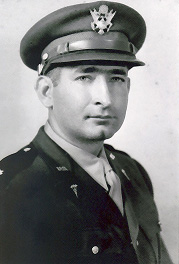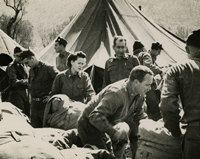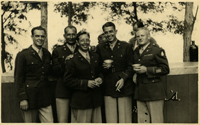Major Hubert B. Holsinger, M.D., Surgeon
John L. Guerrant | Hubert B. Holsinger | Alice M. Huffman | Frank L. Lowther | Randal Luscombe | Dorothy Sandridge | Melvin C. Shaffer | William P. Snavely | Beverley D. Tucker | Frances E. Wells | 8th EVAC home

Hubert B. Holsinger
Dr. Hubert B. Holsinger, better known as “Shine,” was born in McGaheysville, Virginia on August 29, 1904, the son of Annie Burner and Gabriel F. Holsinger. His father was principal of the local high school and a farmer. Both grandfathers were Civil War veterans. His paternal grandfather was a courier, first for Jeb Stuart and then for Stonewall Jackson. He was taken as a prisoner of war two days before Jackson was killed. His mother’s father was a member of the 6th Virginia Cavalry throughout the war and was wounded four times.
Holsinger earned his undergraduate degree from Bridgewater College in 1924 and graduated from the University of Virginia School of Medicine in 1928. He did additional training at the Yale-New Haven Hospital and at Cornell before moving in 1932 to Farmville, Virginia where he practiced general surgery, urology, and orthopedics at the Southside Community Hospital. He joined the 8th Evacuation hospital in 1942 and was a Lieutenant-Colonel by the time he left the Army Medical Corps in 1946. After the war he returned to Farmville and practiced medicine at Southside until his retirement in 1968. He married Eula Wright, an 8th Evac nurse, in 1949. He wrote about his life for a School of Medicine 50 year class reunion. His eleven page memoir has seven pages devoted to his time serving with the 8th Evac. Those seven pages form the basis of the following essay. Dr. Holsinger died in 1983.
I joined the 8th Evacuation (University of Virginia) World War II Hospital as a head of a surgical team, going from Farmville to maneuvers in the Carolinas to Fort Benning, Georgia and then on to Camp Kilmer in New Jersey. After many alerts at Kilmer we were finally shipped out on the Santa Paula which was part of the largest armada of ships, battleships, air craft carriers, cruisers, destroyers, and transports ever assembled. The Santa Paula was a cruise ship which ordinarily carried 300 passengers. There were 5,000 of us on the ship for this cruise. Before embarking we had been supplied with “cold weather clothing.” On the second day out, closed orders were opened telling us we would land on the west coast of Africa. Because of the expected danger, our nurses were left behind, and we were given a contingent of male nurses. We boarded ship on the evening of November 1, 1942 and sailed a zigzag course to Casablanca.
On November 20th we were landed on the coast of Casablanca, Morocco from a landing craft for infantry. There was no fighting. All of the French ships that had remained in Casablanca harbor were either burning or sunk. After much labor, both by Arabs and our own men, we opened a 27 ward hospital in the Italian consulate building in Casablanca. We “smart” medical officers had calculated our distance from enemy territory and decided it was too far for German bombers to come so we never bothered to learn how to turn off the lights in the hospital or on the street corner. On New Years Eve the German bombers came over, and it seemed to me they flew directly over the hospital so as to zero in on the ships in the harbor. We never were able to turn off the hospital lights or the street light on the corner. They set some Arab buildings on fire and a warehouse, otherwise there was no damage. One of our men was slightly wounded in the leg by falling shell fragments.
On March 18, 1943 we moved to Anfa Hill. Our 750 bed hospital became a tent city acting as a convalescence hospital. In July we boarded a train that was full of lice and bedbugs with no window in the coaches. It was really something riding through the numerous tunnels in the mountains behind a coal-burning engine and open coaches. Near Algiers, Algeria we set up in a beautiful, green meadow for an unneeded vacation of six weeks swimming in the Mediterranean and just loafing. As a matter of fact, we were a lost hospital, having supposedly been on our way to Sicily. Our advance unit had gone ahead of us. When we were finally located by the Army, we were moved from there to Oran and bivouacked on Goat Hill which was a dismal, dusty old battlefield full of fox holes and other things that go with battle.
On September 15th we moved from Goat Hill to board a British ship transport, the Durban Castle. Every morning for breakfast they served boiled cabbage which I could not eat. We landed on the beach at Paestum, Italy in the Gulf of Salerno on D12, September 21st. In the crossing our supply ship was sunk by a torpedo so all we had was what we carried on our back plus our bedding roll. We lost all hospital equipment. The first couple of nights we spent in abandoned fox holes, and everyone but me had intense diarrhea including the nurses. A German airplane wing was propped up, and one side was for use of the females and the other side for males.
Moving day: Eula Wright is center left and Holsinger, her future husband, is standing next to her.
As we moved up Italy, a lot of interesting and unusual things seemed to happen. Some of us on a visit to Capri got caught on the island by a Mediterranean storm and were A.W.O.L. for three days. Just as we got back to Naples the German bombers came over and not knowing where the bomb shelters were, we started to follow the fleeing Italians down a dark street. Someone had left a light on in a second story room. One of the Italians picked up a cobblestone from the street and with one throw went through the window with the rock and knocked out the light bulb. Needless to say, we hurried on out of Naples.
While we were north of Naples, Vesuvius erupted for a number of days, and it was quite an aerial display. I always felt that the shaking of the ground from the firing of the artillery may have had something to do with the starting of the eruption. You could actually feel the ground shake when the guns were fired. We were up on top of Vesuvius sightseeing about one week before it erupted.
On one of those cloudy, murky days so common in sunny Italy I happened to be standing in my tent and looked up at a hole in the overcast and through it nine Messerschmidts dived straight down, pointing straight at the point where I was standing, but they did not open fire until they got over the edge of the hospital. However, they had hardly cleared the trees before the British on the hill next to us opened fire on them with their machine guns. It was only a few minutes before a British Spitfire flying at about 300 feet came down the road beside the hospital, and the same British troops opened fire on their own plane. Fortunately they did not injure it in any way.
We moved further on up the road towards Rome, and I went forward with a communication officer to watch the bombardment of Mt. Lungo. General Mark Clark, the Allied Commander in Italy, was there, and the Germans were very quiet, I expect, because of the intense fire from our own artillery. There was a beautiful fruit tree orchard on the side of the road which I thought was just the right size for our hospital, and it would have made an excellent and colorful sight. The executive officer and I went up the next day to look it over with the idea of moving to that area, but the Germans began shelling, and an 88 (you see the shell burst before you hear the whine of the shell) began to bracket us in. We ducked under an arch of a cemetery there, and when the 88 had its four corners, we ducked out as quickly as possible. A week later we went by this arch, and a shell had dropped directly through the middle of it.
Left to right, Hairfield, Holsinger, Low, Thornton, and Drash
While there we watched a platoon of eight men go forward for observation. The rear man had a large book in his hip pocket. The next morning Bev Hairfield, the other surgeon on my team, and I got this man and took quite a while cleaning out devitalized gluteal muscle and especially picking out the fragmented leaves of The Grapes of Wrath which happened to be the book that he had in his pocket.
Every evening when the full moon came up at a hospital north of Florence, we were amused by a German plane shooting at shadows on the side of the hill next to where we were, thinking the shadows were pup tents. But one night while we were operating, a splinter bomb was dropped, hitting a locust tree that was about 75 feet from the surgical tent in which we were working. The splinters from the bomb fragmented and tore the leaves of the tree as if they had been cut with scissors, and the side of the house next to which the tree stood was pockmarked terribly badly. None of the fragments hit the surgical tent, but one fragment went over the tent and gave one of the boys in our outfit a minor wound. We spent the last Christmas just north of Florence at Radicosa Pass, and to celebrate Christmas the soldiers had a large lighted Christmas tree atop the pass.
It was always interesting to me to see how quick the reaction of men on the line could be. We moved from this field hospital across a hill over into the next valley, and one night standing in front of the tent I saw a man half way up the valley light a cigarette, I suppose it was a man. Before the flame died down the Germans and the Americans both had bombarded the hill terrifically, and whoever had lit the match never, I suppose, lived to tell about it.
Over the course of the war we traveled the length of Italy, and on May 4, 1945 the German Army in Italy surrendered. For a complete story of the University of Virginia Eighth Evacuation Hospital read Byrd Leavell’s book, The Eighth Evac. At the end of the war Cato Drash was Commanding Officer, Byrd Leavell was Chief of Medicine, and I was Chief of Surgery. During its three years in Africa and Italy the hospital cared for 48,047 patients; 31,057 with diseases, 10,487 battle casualties, and 7,563 with injuries. Another 45,000 were treated in the out-patient department.
At war’s end in Italy almost everyone in the 5th Army got a ten day trip through Switzerland, paying for the trip out of their own pockets. However, it cost us only 35 dollars for the train ticket, 35 dollars for the hotel and food, and 35 dollars for spending money. This was a wonderful change for us to go to a nice, clean, friendly country from war torn Italy. We visited Interlaken, Luzerne, Yung Frau, Bern, and Zurich. The trip was made in the middle of August, and it was on this trip that a picture of Eula Wright and me was taken. Though shadows mar our faces, I don’t believe that any other picture could express the relief and the happiness we had at that time, being completely away from all the thoughts and miseries of war. We spent about two months on the shore of Lake Garda which was located near Desenzano close to Austria taking care of an occasionally injured or sick soldier but mostly enjoying the sunshine and the swimming in the lake.
After the outfit was deactivated we spent several months at Leghorn waiting for a ship to take us home, and what a ship it (Richard Bassett) turned out to be! There were 800 troops who had had the most time overseas, aboard. While at Leghorn we received excellent food, but on the ship we received two meals a day. Breakfast consisted of two hard boiled eggs, the yellows were black and the whites were yellow. Dinner was a bowl of watered down soup. In my wanderings around the ship, I found the freezing compartment, and it was crammed full with sides of beef. I have often wondered what became of that meat.
Anyway, we were met at Newport News by a band and Red Cross girls with a pint of milk for every soldier. I did receive a Bronze Star while in Italy. During my first year back I learned patriotism stops when the band stops playing. When I joined up, I had a fairly good practice, but my first year back I didn’t make expenses and was just making plans for leaving when an older surgeon became ill, and I took over most of his practice. On December 4, 1949 Eula Wright and I were married.
John L. Guerrant | Hubert B. Holsinger | Alice M. Huffman | Frank L. Lowther | Randal Luscombe | Dorothy Sandridge | Melvin C. Shaffer | William P. Snavely | Beverley D. Tucker | Frances E. Wells | 8th EVAC home

